Papers in 2022
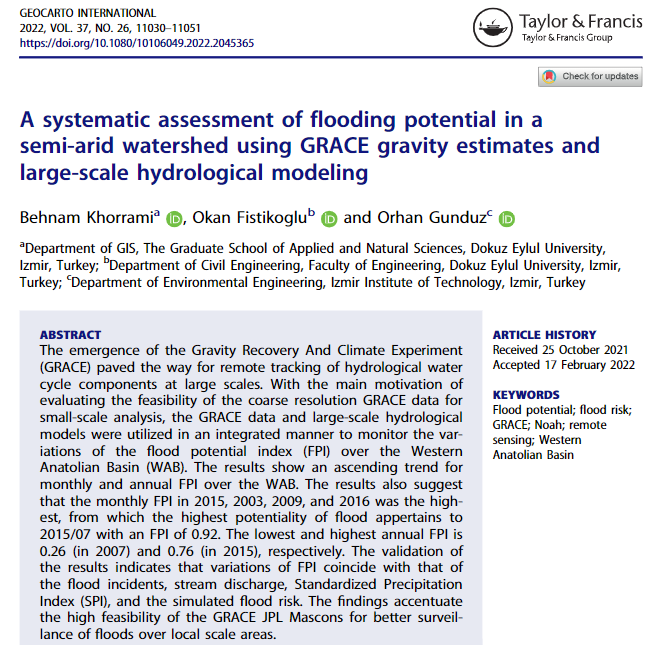
A systematic assessment of flooding potential in a semi-arid watershed using GRACE gravity estimates and large-scale hydrological modeling
Floods are devastating natural phenomena that affects human societies, ecosystems, and agricultural and industrial infrastructures. Given the predicted increase in their frequency and intensity, flood monitoring and assessment are crucial. This study aimed to assess the feasibility of using coarse-resolution Gravity Recovery and Climate Experiment (GRACE) data for flood analysis and to provide cost-effective datasets for flood investigation and monitoring. The study utilized data from GRACE and large-scale hydrological models to track changes in the flood potential index (FPI) over the West Anatolian Basin (WAB). The findings indicate a rising trend in monthly and annual FPI over the WAB, with the highest flood potential occurring in July 2015, with an FPI value of 0.92. The study concludes that the coarse-resolution GRACE JPL mascon is suitable for monitoring spatiotemporal flood events over local scales.
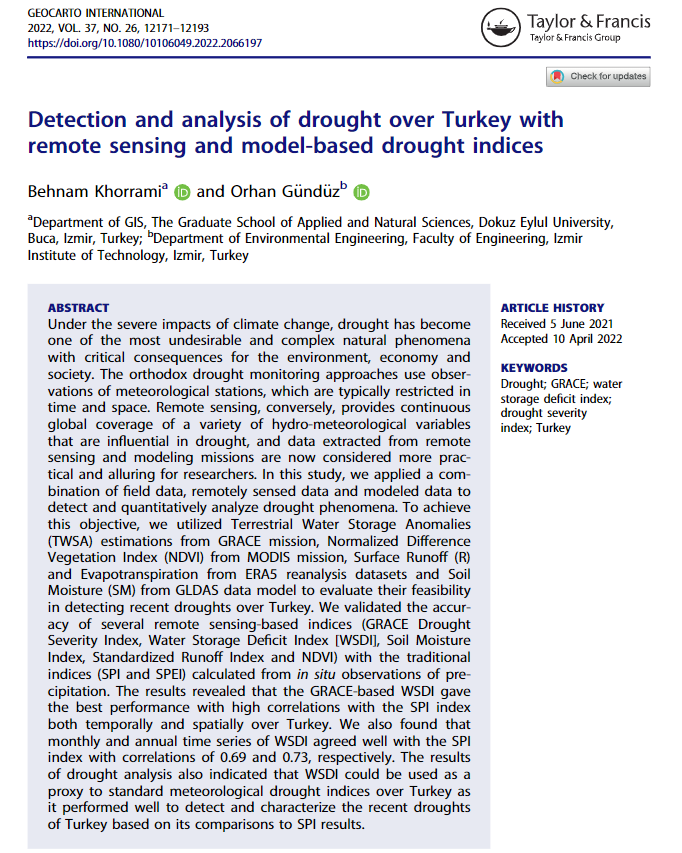
Detection and analysis of drought over Turkey with remote sensing and model-based drought indices
Due to climate change, drought has become a large and complex natural phenomenon with severe consequences for the environment, economy, and society. While traditional drought monitoring approaches have limitations in terms of time and space, remote sensing provides continuous global coverage of hydro-meteorological variables, and data from it makes it practical for researchers. This study aimed to detect and quantitatively analyze drought events using field, remote sensing and modeled data. Estimates of Terrestrial Water Storage Anomalies (TWSA) from the GRACE task, Normalized Vegetation Index (NDVI) from MODIS, Surface Flow, Evapotranspiration, and Soil Moisture from different data models were used to evaluate their feasibility in detecting recent droughts in Turkey. The study validated the accuracy of several remote sensing-based indices with conventional indices calculated from on-site precipitation observations. As a result, it was concluded that the GRACE-based Water Storage Gap Index (WSDI) gave the best performance in detecting and characterizing recent droughts in Turkey compared to traditional indices.

Countrywide Spatial Variation of Potentially Toxic Element Contamination in Soils of Turkey and Assessment of Population Health Risks for Nondietary Ingestion
Countrywide surface soil concentrations of potentially toxic elements (PTEs) in Turkey were reviewed in the Web of Science database. A total of 93 papers were investigated to compose a PTE dataset for determining spatial variations and estimating exposure and health risks. Al, As, Cd, Co, Cr, Cu, Fe, Mn, Ni, Pb, and Zn were selected as PTEs in surface soil. A compiled PTE concentration dataset was used to estimate chronic toxic risks (CTRs) and carcinogenic risks (CRs) according to the deterministic and probabilistic approaches. While the CTR and CR levels of age and sex groups were estimated using a deterministic approach, population risks were estimated using a probabilistic approach. CTR and CR levels in lower age groups and female sex groups were estimated to be higher than those in higher age groups and associated male sex groups. The average CTR levels of the nondietary ingestion of As-containing soil in <11 year age groups were near/just above the threshold level, while As-associated average CR levels of adults and other age groups were estimated to be in the acceptable risk range (10−6<CR<10−5) and low priority risk range (10−5<CR<10−4), respectively. As-, Cr(VI)-, and Pb associated upper-bound CR levels of the Turkish population were simulated to be 5.14 × 10−4, 6.23 × 10−5, and 2.34 × 10−6, respectively. Health risk models show the significance of As in both chronic toxic and carcinogenic effects.

Indoor environmental quality in naturally ventilated schools of a dusty region: Excess health risks and effect of heating and desert dust transport
The indoor environmental quality (IEQ) is affected by the outdoor air in naturally ventilated buildings. Students’ health and academic performance can be affected in poorly ventilated schools. This study investigated the effects of anthropogenic and natural sources (such as periodic dust storms) on five naturally ventilated schools in Şanlıurfa province. The potential health effects of particulate matter and carbon dioxide levels on students were investigated. Thermal and acoustic comfort parameters were also analyzed, and suggestions were made for students to have a more successful academic life. The findings suggest that mechanical ventilation systems with particle filtration are necessary to reduce potentially adverse health effects on children. Mechanical ventilation is essential in schools but becomes more critical in regions prone to periodic dust transfer.
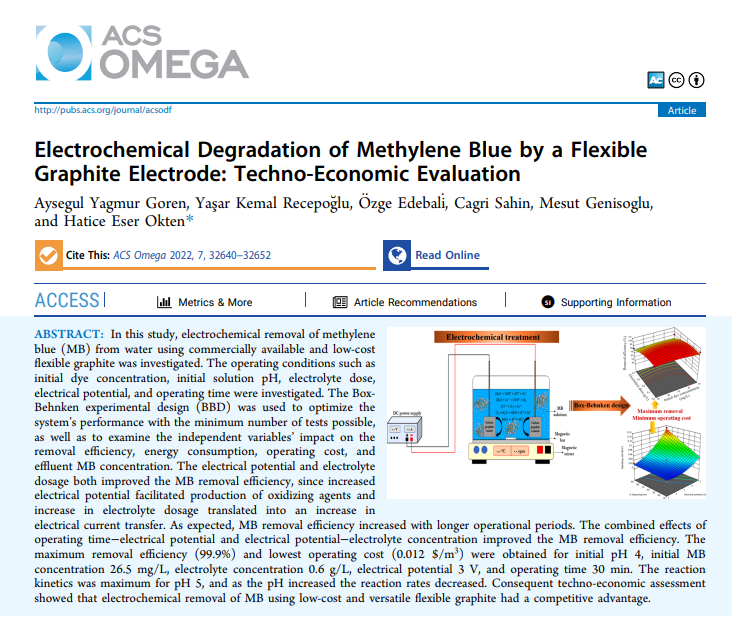
Electrochemical Degradation of Methylene Blue by a Flexible Graphite Electrode: Techno-Economic Evaluation
Direct discharge of highly colored textile wastewater has negative impacts on aquatic life and can cause harmful effects on human health. This study investigated the removal of methylene blue (MB) from water using readily available and low-cost flexible graphite. Operating conditions were examined, such as dye concentration, pH, electrolyte dose, electrical potential, and operational time. The Box-Behnken experimental design (BBD) was used to optimize the system performance with the least number of tests and examine independent variables’ effect on removal efficiency, energy consumption, operating cost, and waste MB concentration. It was observed that electrical potential and electrolyte dose increased MB removal efficiency. The combined effects of operational time-electrical potential and electrical potential-electrolyte concentration also increased MB removal efficiency. As a result, a technological-economic evaluation showed that MB removal by electrochemical means using cheap and flexible graphite has a competitive advantage.

3D electrode use in MDC for enhanced removal of boron from geothermal water
Microbial desalination cell (MDC) is a significantly promising technology due to its simultaneous features of electricity production, wastewater treatment, and desalination. In this paper, the three-dimensional (3D) sponge with activated carbon-chitosan (AC-CS) was synthesized to enhance the efficiency of the MDC system. The MDC with 3D AC-CS anode provided a higher power density of 970 mW/m2, the boron removal efficiency of 75.9%, and COD removal efficiency of >90% under optimized conditions. The maximum boron and COD removal efficiencies were 65.6 and 81.4%, with a power density of 866.9 mW/m2 for geothermal brine. As an overall result, not only the production of 3D sponge anode electrodes with AC-CS composite was achieved but also desalination and power generation results that were comparable with the literature were presented.
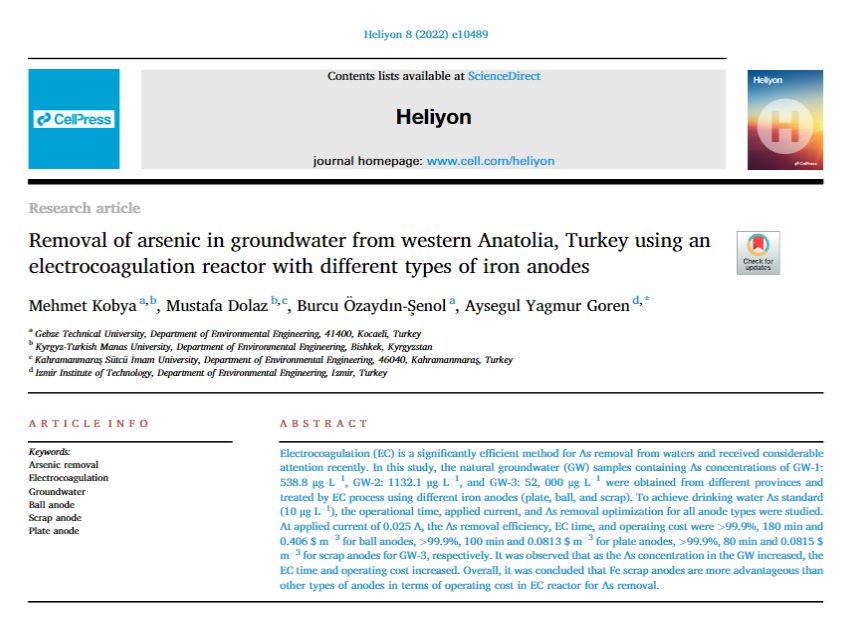
Removal of arsenic in groundwater from western Anatolia, Turkey using an electrocoagulation reactor with different types of iron anodes
Electrocoagulation (EC) is a significantly efficient method for arsenic (As) removal from waters and received considerable attention recently. In this study, the natural groundwater (GW) samples containing As concentrations of GW-1: 538.8 μg/L, GW-2: 1132.1 μg/L, and GW-3: 52,000 μg/L were obtained from different provinces and treated by EC process using different iron anodes (plate, ball, and scrap). To achieve drinking water As standard (10 μg/L), the operational time, applied current, and As removal optimization for all anode types were studied. At the applied current of 0.025 A, the As removal efficiency, EC time, and operating cost were >99.9%, 80 min, and 0.0815 $/m3 for scrap anodes for GW-3, respectively. Overall, it was concluded that Fe scrap anodes are more advantageous than other types of anodes in terms of operating cost in EC reactor for As removal.
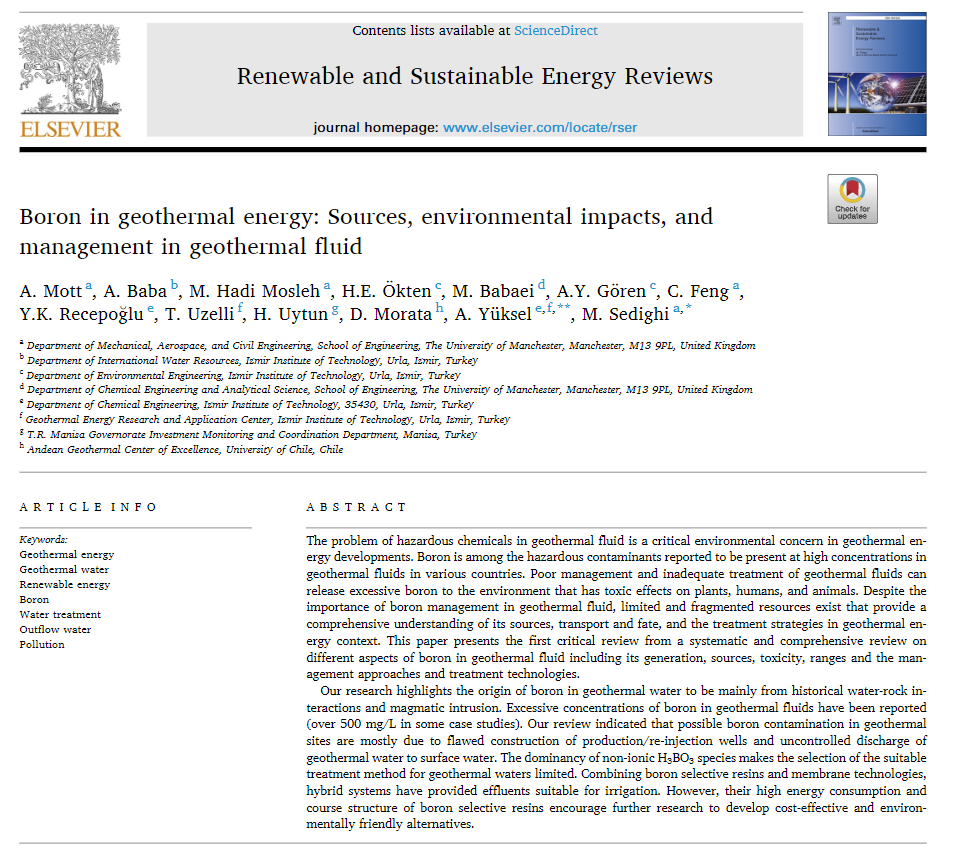
Boron in geothermal energy: Sources, environmental impacts, and management in geothermal fluid
The problem of hazardous chemicals in a geothermal fluid is a critical environmental concern in geothermal energy developments. Boron is among the hazardous contaminants reported to be present at high concentrations in geothermal fluids in various countries. Poor management and inadequate treatment of geothermal fluids can release excessive boron to the environment that has toxic effects on plants, humans, and animals. This paper presents the first critical review from a systematic and comprehensive review on different aspects of boron in geothermal fluid including its generation, sources, toxicity, ranges and the management approaches and treatment technologies.
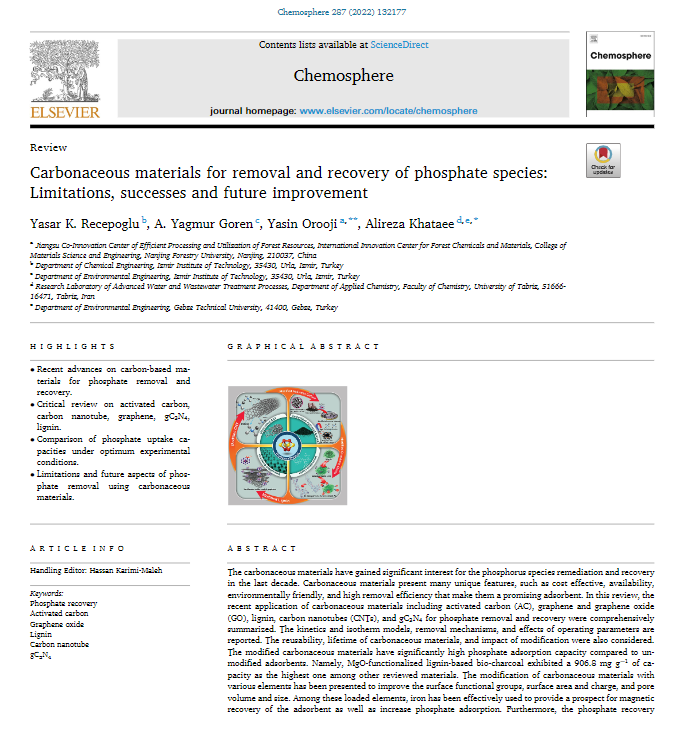
Carbonaceous materials for removal and recovery of phosphate species: Limitations, successes and future improvement
The carbonaceous materials have gained significant interest for the phosphorus species remediation and recovery in the last decade. Carbonaceous materials present many unique features, such as cost effective, availability, environmentally friendly, and high removal efficiency that make them a promising adsorbent. In this review, the recent application of carbonaceous materials including activated carbon (AC), graphene and graphene oxide (GO), lignin, carbon nanotubes (CNTs), and gC3N4 for phosphate removal and recovery were comprehensively summarized. Furthermore, the phosphate recovery methods, phosphate removal efficiency of carbonaceous materials, the limitations, important gaps in the literature, and future studies to enhance applicability of carbonaceous materials in real scale are also discussed.
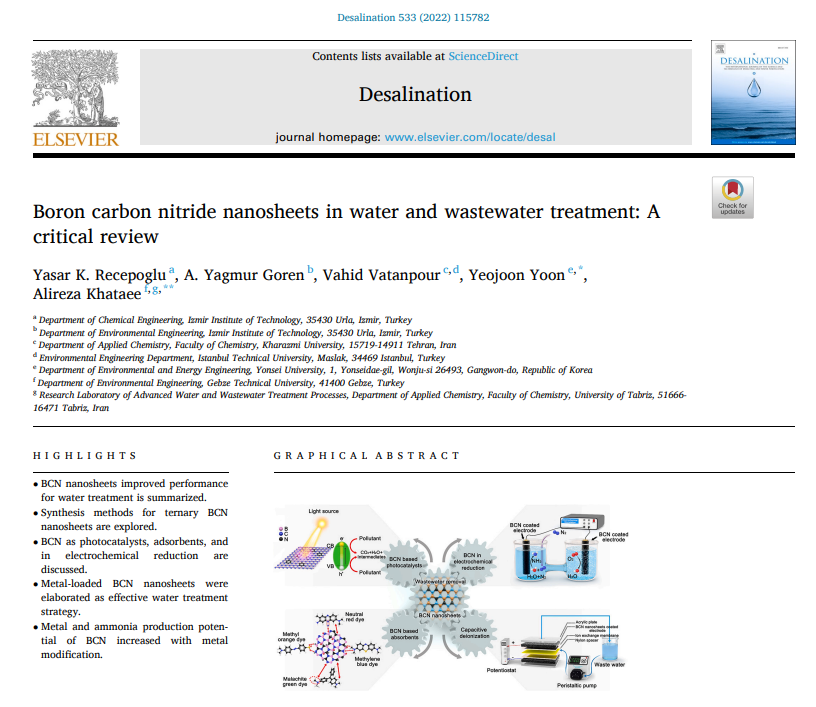
Boron carbon nitride nanosheets in water and wastewater treatment: A critical review
The availability and accessibility of clean and secure water supplies are pressing technological and scientific issues worldwide. As a result of global water constraints, wastewater treatment, and reuse are being evaluated as feasible alternatives to fresh water for agricultural irrigation and domestic and industrial purposes. Boron carbon nitride (BCN) nanosheets have been studied intensively in the last decade in batteries, biosensors, and capacitors and for use as catalysts, and they have recently been used in wastewater treatment. BCN materials, along with their synthesis processes, characteristics, and application areas in water and wastewater treatment, are discussed thoroughly in this paper. BCN materials have also been explored because of their flexible electrical features, excellent mechanical strength, outstanding unreactivity, and significant stability, making them appropriate for various severe environment applications. Thus, the use of BCN materials as photocatalysts and adsorbents and in electrochemical reduction and capacitive deionization are also discussed thoroughly. Overall, this review indicates that essential work on BCN nanosheets is still needed. Future research should focus on developing BCN nanostructures to encourage multidisciplinary research.
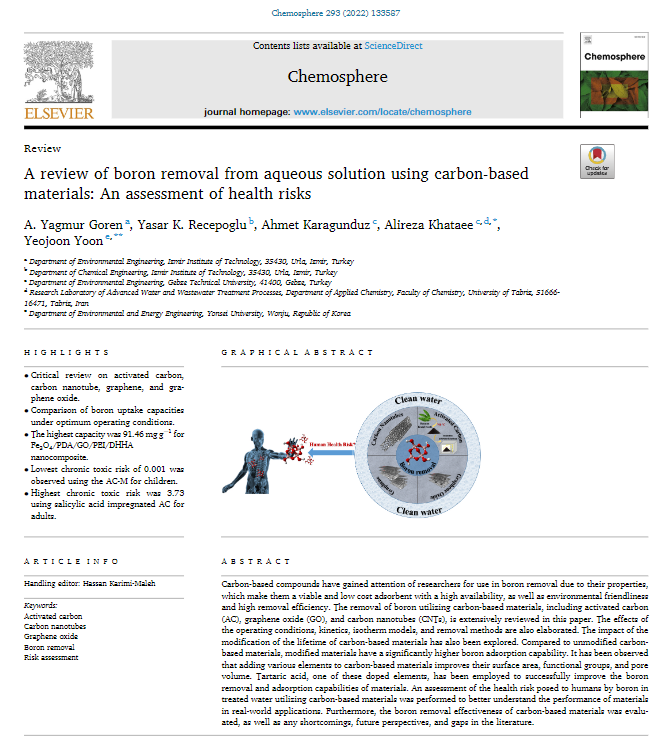
A review of boron removal from aqueous solution using carbon-based materials: An assessment of health risks
Carbon-based compounds have gained attention of researchers for use in boron removal due to their properties, which make them a viable and low cost adsorbent with a high availability, as well as environmental friendliness and high removal efficiency. The removal of boron utilizing carbon-based materials, including activated carbon (AC), graphene oxide (GO), and carbon nanotubes (CNTs), is extensively reviewed in this paper. An assessment of the health risk posed to humans by boron in treated water utilizing carbon-based materials was performed to better understand the performance of materials in real-world applications. This review revealed that future studies should examine the environmental consequences, economic effects, and hazards posed by the adsorbents and resulting treated water to gain insights into potential commercial applications.
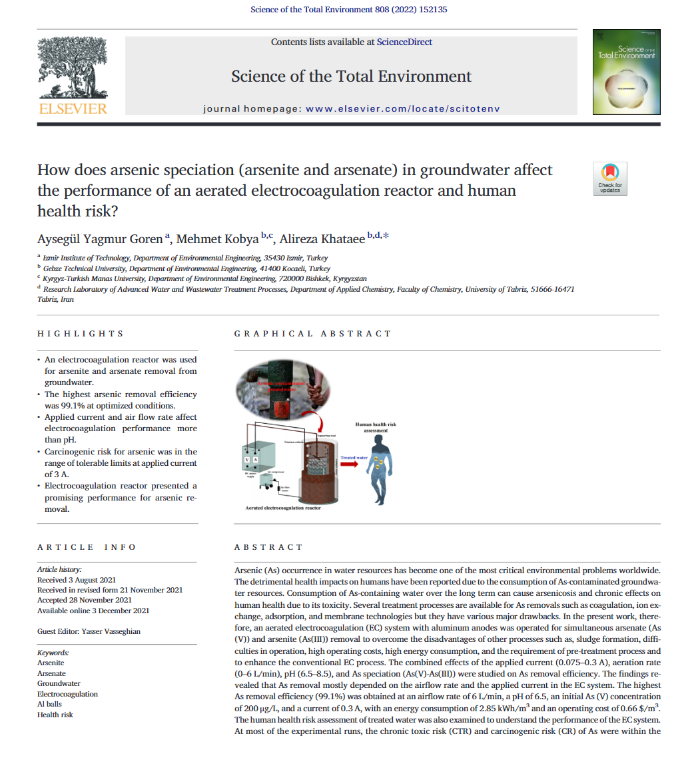
How does arsenic speciation (arsenite and arsenate) in groundwater affect the performance of an aerated electrocoagulation reactor and human health risk?
Arsenic (As) occurrence in water resources has become one of the most critical environmental problems worldwide. The detrimental health impacts on humans have been reported due to the consumption of As-contaminated groundwater resources. Consumption of As-containing water over the long term can cause arsenicosis and chronic effects on human health due to its toxicity. In the present work, an aerated electrocoagulation (EC) system with aluminum anodes was operated for simultaneous arsenate (As(V)) and arsenite (As(III)) removal to overcome the disadvantages of other processes such as, sludge formation and difficulties in operation. The human health risk assessment of treated water was also examined to understand the performance of the EC system. Overall, the As removal performance and groundwater risk assessment show that the EC process is a promising option for industrial applications.
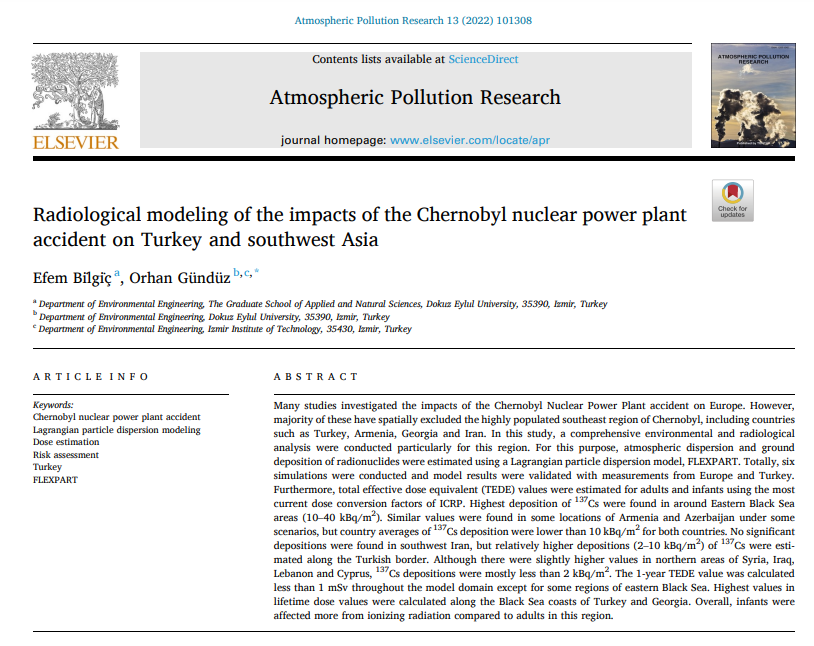
Radiological modeling of the impacts of the Chernobyl nuclear power plant accident on Turkey and southwest Asia
Most studies have spatially excluded the highly populated southeast region of Chernobyl, including countries such as Turkey, Armenia, Georgia and Iran. Highest deposition of 137Cs were found in around Eastern Black Sea areas (10–40 kBq/m2). Total effective dose equivalent (TEDE) values were estimated for adults and infants using the most current dose conversion factors of ICRP. Highest values in lifetime dose values were calculated along the Black Sea coasts of Turkey and Georgia. Overall, infants were affected more from ionizing radiation compared to adults in this region.
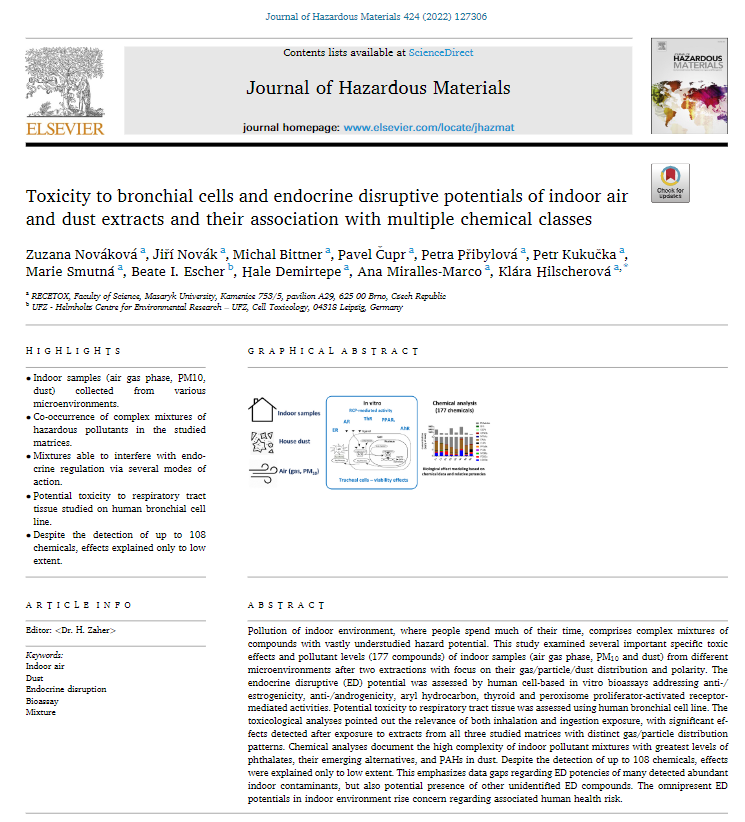
Toxicity to bronchial cells and endocrine disruptive potentials of indoor air and dust extracts and their association with multiple chemical classes
People spend most of their time indoors containing complex pollutants with largely unstudied hazardous potentials. These pollutants can either be inhaled or ingested through the dust. Some have been identified as endocrine-disrupting compounds posing health risks, particularly for young children with sensitive developing hormonal systems. The study found that indoor pollution mixtures contain compounds with endocrine-disrupting activities in gas and particulate phases of indoor air and dust in lecture rooms, offices, and households. The study confirms the suitability of specific bioanalytical in vitro tools and the relevance of human cell-based models in assessing mixture toxicity. The research also documents the presence of thyroid hormone-like and PPARγ-activating compounds in indoor environments. The results highlight the need for further investigation of human health-relevant endocrine-disrupting potencies of indoor pollutants, especially the most abundant ones like phthalates and their alternatives.
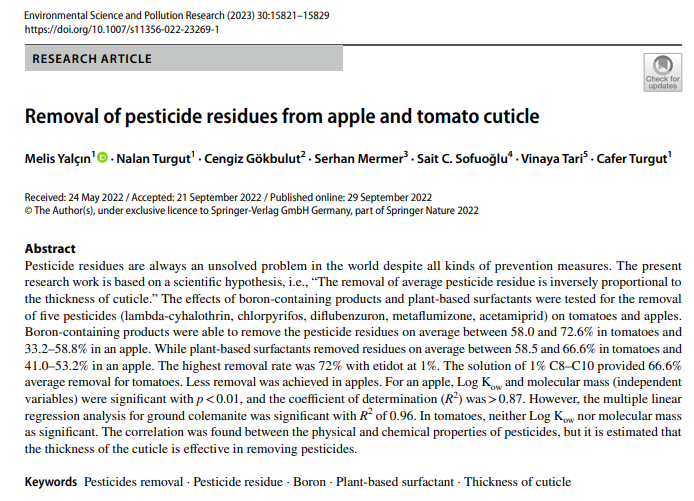
Removal of pesticide residues from apple and tomato cuticle
Apples and tomatoes are two of the most regularly consumed fruits and vegetables worldwide, demonstrating the importance of sustainable agriculture in world food production. However, the extensive use of pesticides in agriculture may result in high levels of harmful chemical residues in fruits and vegetables, which may negatively impact the environment and human health. This research aimed to determine the relationship between the removal of average pesticide residue and the thickness of cuticles on fruits such as tomatoes and apples. The study tested the effectiveness of boron-containing products and plant-based surfactants in removing five pesticides from fruits. The results showed that both boron-containing products and plant-based surfactants were effective in removing pesticide residues. The physical and chemical properties of pesticides correlated with the removal rate, but the thickness of the cuticle was the most influential factor.
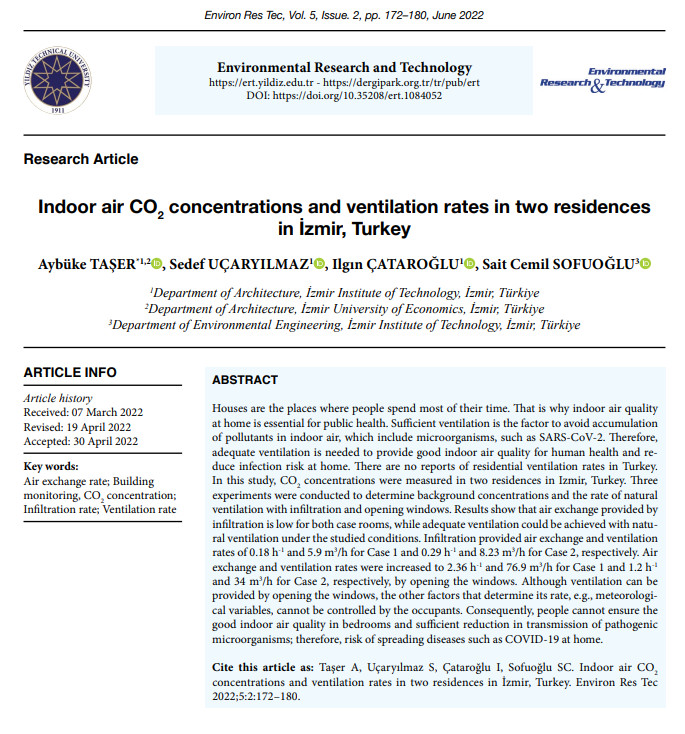
Indoor air CO2 concentrations and ventilation rates in two residences in İzmir, Turkey
Indoor air quality at home is crucial for public health as people spend most of their time at home. Adequate ventilation is necessary to prevent the accumulation of pollutants and microorganisms, such as SARS-CoV-2, in indoor air. This study measured CO2 concentrations in two residences in Izmir, Turkey, and found that while opening windows provide ventilation, the rate is uncertain due to factors like meteorological variables that occupants cannot control, leading to a potential risk of spreading diseases like COVID-19. Natural ventilation significantly reduces indoor CO2 concentration, but it depends on various factors such as housing type, location, window size, and air tightness. The rates of infiltration and natural ventilation estimated in this study are relatively low and insufficient in controlling the spread of infections like COVID-19.
